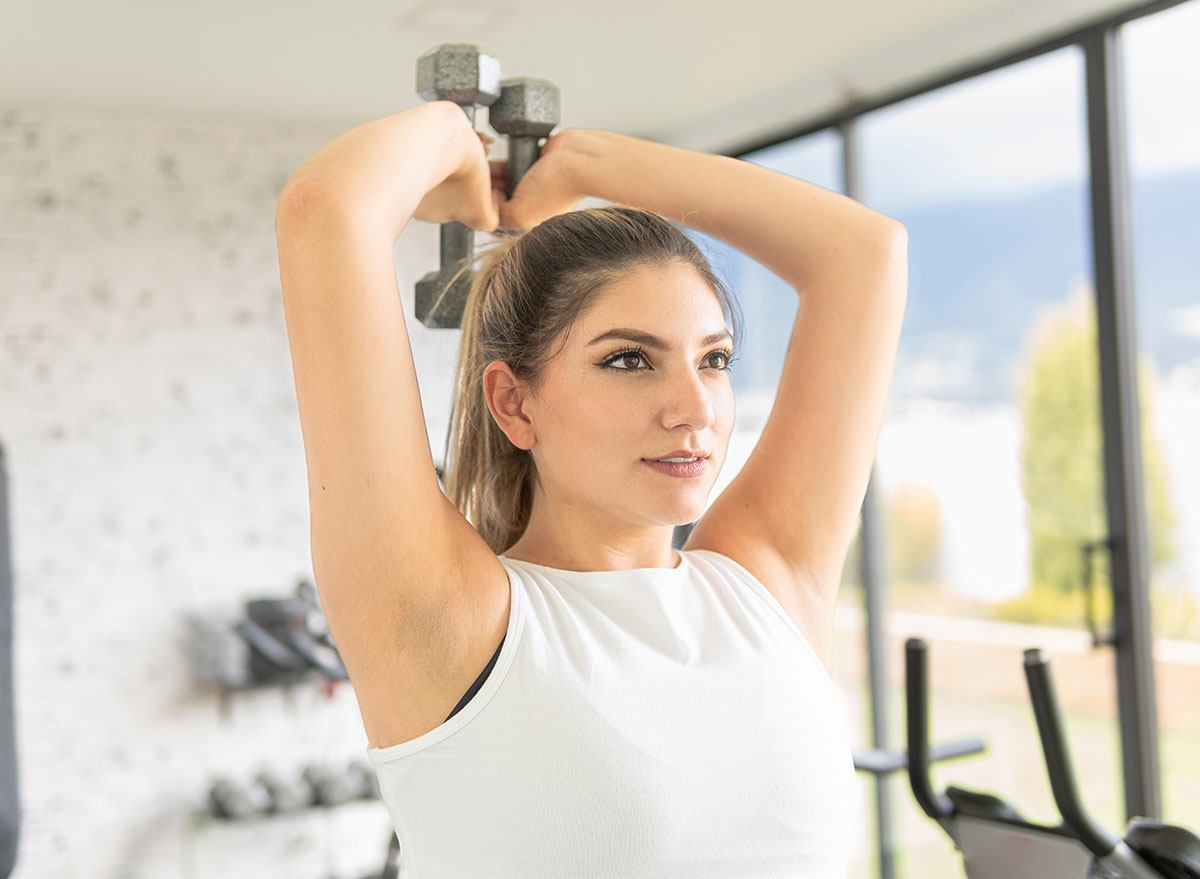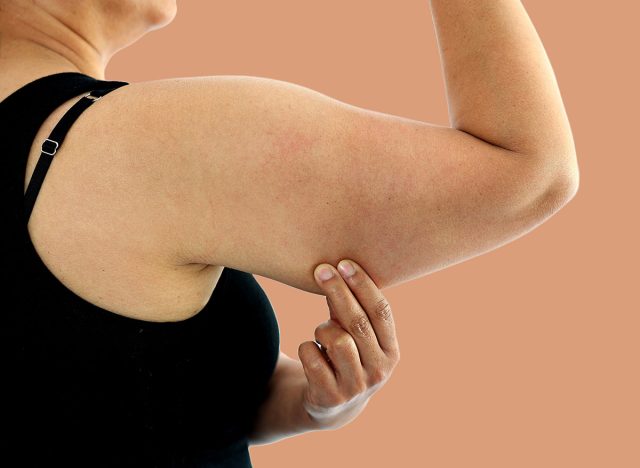7 Best Standing Exercises That Banish Bat Wings in 30 Days After 45

Aging has a way of reminding us that gravity always wins, but your arms don’t have to surrender. The so-called “bat wings” that hang around your triceps and upper arms are often just a mix of underused muscle and extra body fat. While you can’t magically melt fat from one specific spot, you can reshape and firm the area by building lean muscle, increasing calorie burn, and staying consistent. That combination is what truly transforms the way your arms look and feel after 45.
Spot reduction might be a myth, but movement certainly isn’t. Every time you pick up a dumbbell or push against resistance, you’re telling your body to adapt. This results in stronger muscle fibers, tighter skin tone, and improved overall metabolism. When you combine that effort with solid nutrition and consistent daily movement, those “bat wings” don’t stand a chance.
Secondly, you don’t need an elaborate setup or fancy gym equipment. Most of these standing exercises can be done right in your living room with a pair of dumbbells or resistance bands. For those who like mixing things up, a cable station at the gym offers even more variety and control. You’ll strengthen your shoulders, biceps, and—most importantly—the triceps that give your arms a sculpted look.
The following seven moves are your roadmap to firmer, stronger, and more defined arms. Each one targets a key muscle group that keeps your upper body looking powerful and athletic.
Standing Exercise #1: Dumbbell Overhead Tricep Extensions
This classic arm-toning move zeroes in on the long head of your triceps, the area most responsible for that loose underarm skin. By lifting overhead, you stretch the muscle fully and engage stabilizers through your shoulders and core. Over time, this exercise helps create the lean, firm shape that defines the back of your arms.
Muscles Trained: Triceps, shoulders, core
How to Do It:
- Stand tall with your feet shoulder-width apart and hold one dumbbell overhead with both hands.
- Keep your elbows close to your ears and your upper arms still.
- Bend your elbows to lower the dumbbell behind your head.
- Pause briefly at the bottom.
- Extend your arms to return to the starting position.
Recommended Sets and Reps: Knock out 3 sets of 12 to 15 reps. Rest for 45 seconds between each set.
Best Variations: Single-arm overhead tricep extension, seated overhead tricep extension, resistance band overhead extension
Form Tip: Keep your ribs tucked and core braced to prevent your back from arching.
Standing Exercise #2: Standing Front Raise
The front raise strengthens the front of your shoulders and upper chest, while helping to define your upper arm. Building this area gives your arms a balanced appearance and improves posture. The movement also challenges shoulder stability and teaches proper control, which in turn leads to improved movement in daily life.
Muscles Trained: Front deltoids, upper chest, biceps
How to Do It:
- Stand tall with a dumbbell in each hand, palms facing your thighs.
- Keep your arms straight with a slight bend in your elbows.
- Raise the dumbbells in front of your body until they reach shoulder height.
- Pause briefly at the top.
- Lower the weights slowly and repeat.
Recommended Sets and Reps: Perform 3 sets of 10 to 12 reps. Rest for 45 seconds between each set.
Best Variations: Alternating front raises, plate front raise, cable front raise
Form Tip: Lift with control and tempo to avoid using momentum or swinging your torso.
Standing Exercise #3: Standing Dumbbell Curl
Curls are the cornerstone of arm training for a reason. They strengthen and shape the biceps, creating a fuller appearance that enhances the entire upper arm. The motion also improves grip strength and elbow stability, two essential qualities for maintaining strength and capability after the age of 45. Consistent curls build lean muscle, increase arm definition, and support balance in the push-pull relationship between biceps and triceps.
Muscles Trained: Biceps, forearms, shoulders
How to Do It:
- Stand with your feet hip-width apart and hold a dumbbell in each hand at your sides.
- Keep your elbows close to your torso.
- Curl the dumbbells toward your shoulders while keeping your palms facing up.
- Squeeze your biceps at the top of the movement.
- Lower slowly to the starting position.
Recommended Sets and Reps: Knock out 3 sets of 10 to 15 reps. Rest for 45 seconds between each set.
Best Variations: Alternating curls, hammer curls, resistance band curls
Form Tip: Keep your elbows locked by your ribs rather than letting them drift forward.
Standing Exercise #4: Standing Dumbbell Kickbacks
Kickbacks hit all three heads of the triceps and are one of the most direct ways to tone and tighten the back of your arms. They’re simple but brutally effective for sculpting lean muscle. The forward hinge position also challenges your core, balance, and posterior chain, helping you maintain a strong, athletic shape overall.
Muscles Trained: Triceps, rear deltoids, core
How to Do It:
- Hold a dumbbell in each hand and hinge forward slightly at your hips.
- Keep your upper arms locked to your sides and your elbows bent at a 90-degree angle.
- Extend your arms straight back until they’re fully extended.
- Squeeze your triceps at the top of the movement.
- Slowly return to the starting position.
Recommended Sets and Reps: Perform 3 sets of 12 to 15 reps. Rest for 45 seconds between each set.
Best Variations: Single-arm dumbbell kickback, cable kickback, resistance band kickback
Form Tip: Move only your forearms, keeping your upper arms still throughout the exercise.
Standing Exercise #5: Standing Lateral Raise
Standing lateral raises build the side deltoids that give your shoulders their rounded, defined look. Strong delts make your waist appear smaller and your arms more athletic. Lateral raises also support shoulder joint health and improve control through the entire range of motion, which becomes increasingly valuable with age.
Muscles Trained: Lateral deltoids, upper traps, rotator cuff
How to Do It:
- Stand with a dumbbell in each hand at your sides.
- Keep a slight bend in your elbows and your palms facing inward.
- Raise your arms out to your sides until they reach shoulder height.
- Pause briefly at the top.
- Lower under control to the starting position.
Recommended Sets and Reps: Knock out 3 sets of 12 to 15 reps. Rest for 45 seconds between each set.
Best Variations: Alternating lateral raise, cable lateral raise, band lateral raise
Form Tip: Lead with your elbows rather than your hands to fully activate your shoulders.
Standing Exercise #6: Standing Cable Pressdown
Cable pressdowns create constant tension on your triceps, leading to superior muscle activation and definition. This exercise is excellent for isolating the back of your arms while reinforcing proper elbow positioning. Over time, it helps carve firm, toned triceps and contributes to stronger pressing movements in everyday life.
Muscles Trained: Triceps, forearms, shoulders
How to Do It:
- Stand facing a cable machine with a straight bar or rope attachment.
- Grip the handle with palms facing down and elbows tucked to your sides.
- Press the bar down until your arms are fully extended.
- Pause at the bottom and contract your triceps.
- Slowly return to the starting position.
Recommended Sets and Reps: Perform 3 sets of 10 to 12 reps. Rest for 45 seconds between each set.
Best Variations: Rope pressdown, reverse-grip pressdown, single-arm pressdown
Form Tip: Keep your shoulders relaxed and elbows fixed throughout each rep.
Standing Exercise #7: Standing Cable Face Pull
Face pulls strengthen the rear deltoids, rhomboids, and traps; key muscles that improve posture and pull your shoulders back for a more upright, confident stance. Strong posterior shoulders also balance your arm development, keeping your upper arms toned from every angle. This move supports shoulder health and helps prevent the rounded appearance that often results from prolonged sitting.
Muscles Trained: Rear deltoids, traps, rhomboids, triceps
How to Do It:
- Set a cable rope attachment at upper-chest height.
- Grip the rope with both hands, palms facing in.
- Pull the rope toward your face while separating your hands.
- Squeeze your shoulder blades together at the end range.
- Slowly return to the start position with control.
Recommended Sets and Reps: Knock out 3 sets of 12 to 15 reps. Rest for 45 seconds between each set.
Best Variations: Band face pulls, seated face pulls, single-arm face pulls
Form Tip: Keep your elbows high and focus on pulling with your rear shoulders, not your arms.
How You Can Best Tone Bat Wings After 45

Consistency and intensity are the secret weapons against bat wings. Perform these exercises two to three times per week, aiming for controlled movements and full muscle engagement. As strength improves, increase the weight or resistance slightly to keep your muscles challenged.
For even faster results:
- Include a brisk daily walk or light cardio to boost calorie burn.
- Prioritize lean protein at every meal to support muscle growth.
- Stay hydrated to help muscles recover and skin appear firmer.
- Get quality sleep. Your body repairs and rebuilds when you rest.
- Stretch your arms and shoulders regularly to maintain mobility and prevent tightness that limits the range of motion.
- Track your progress with photos or performance goals to stay motivated and consistent.